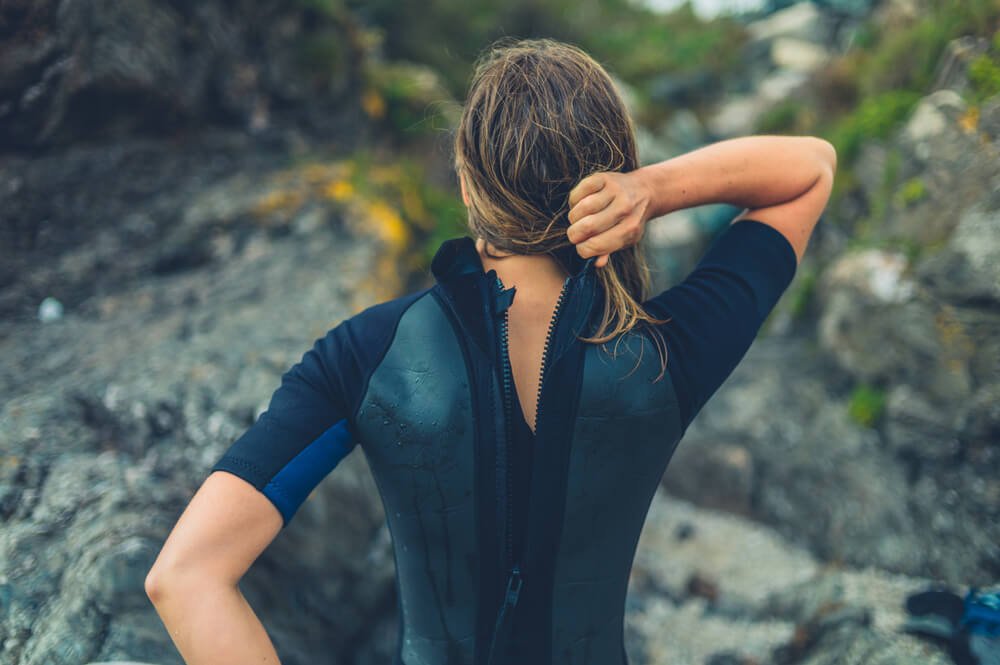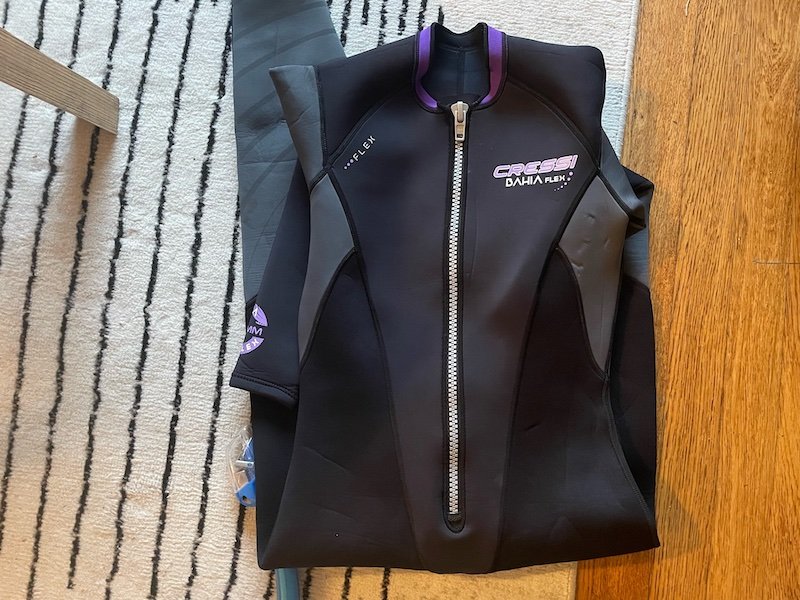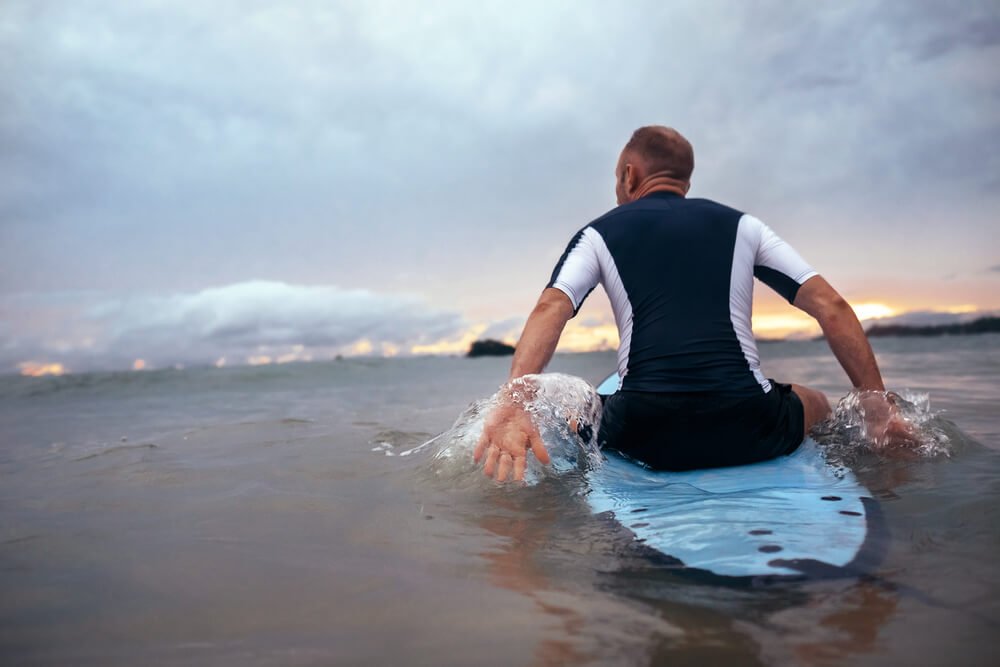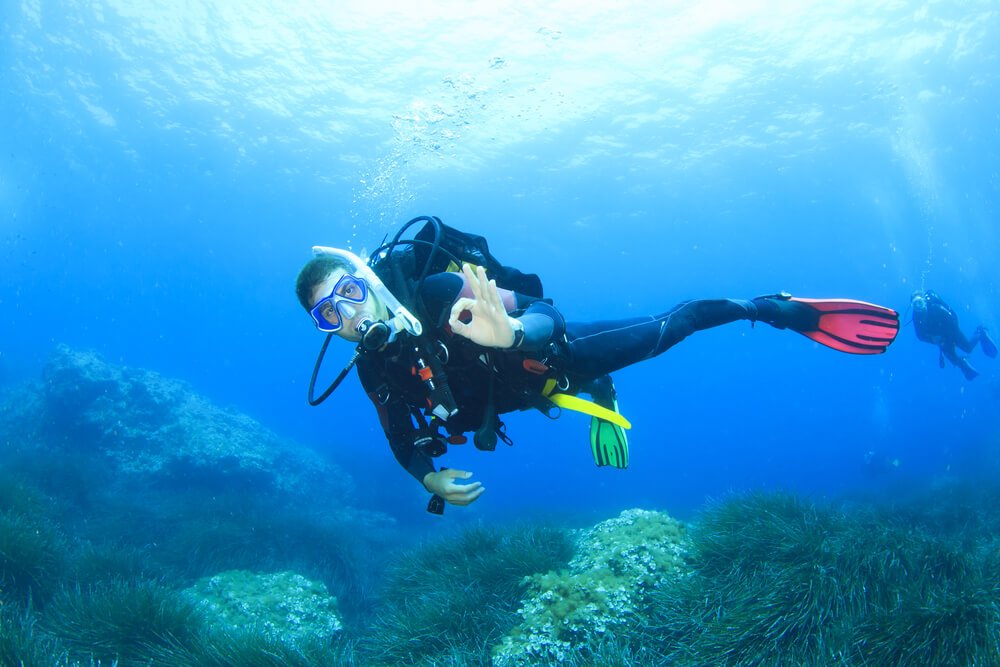Wearing a wetsuit for underwater activities may seem like an open-and-shut case.
After all, a wetsuit is a one piece. Isn’t it one and done?
Not really. Most of the time, you’ll want to wear something underneath your wetsuit (going commando is for the brave, for many reasons).
But a few questions still remain, like exactly what goes beneath it… and how do you decide between so many options?
Don’t worry — I’m here to tell you what to wear underneath a wetsuit. But more importantly, I’ll also explain the use case of each item, like why would you pick a bathing suit in some instances and a neoprene dive vest in others?

Like for example, you’ll want to think about just how much insulation you’ll need from the cold.
The answer will vary greatly if you’re diving in the tropics vs. the frigid California coast’s colder waters!
Another is how how free your movement needs to be. Are you surfing or doing something active? Or are you doing a lazy drift dive?
This post will mostly be focused on what goes under your wetsuit for diving, as that is where my own personal experience lies.
However, you can surely adapt this to also be useful for surfing or other water activities where you might need to wear a wetsuit.
Table of Contents
Why Wear Something Underneath a Wetsuit?

Technically, you don’t need to wear anything under a neoprene wetsuit… but most people do.
Yes, you can go commando, but it’s typically not the best idea. Here are a few main reasons why!
Easy To Change
There are a few ways in which wearing something underneath your wetsuit can help with changing.
For one, it makes changing easy without flashing anyone.
Whenever I surface from a dive, one of the first things I do is unzip my wetsuit to get warm.
Having a bikini top, for example, underneath means I don’t have to worry about anyone getting an eyeful!
Then, I can put a UV-protective dive shirt over my swimsuit, or just allow myself to warm up in the sun if I have sunscreen on (reef-safe, of course).
But also, certain dive garments can make it easier to put on your wetsuit and take it off. This layer creates a barrier between your skin and the neoprene of the wetsuit.

Wetsuits can notoriously be a nightmare to get on and off — especially when wet.
Your skin has more friction than a dive skin, so if you are wearing a dive skin, the wetsuit can slip on and off more easily.
A dive skin can also add insulation and warmth if that’s something you need when you’re in the water.
Another benefit is that it can protect your skin from the rub and tug of the neoprene material — especially in areas where there are tighter spots, zippers, etc.
Not all divers like dive skins — I typically don’t use one, personally.
But if you find it a pain to take your wetsuit on and off and find yourself dreading that part of a dive trip, you may want to check out a dive skin next time!
Comfort

Sometimes, it’s just more comfortable to have a layer between you and your wetsuit, especially if you have sensitive skin that is prone to getting irritated or chafing.
Tugging neoprene wetsuits repeatedly over your bare skin can lead to irritated skin or possibly even open sores if your skin is really sensitive (which puts you at risk for things like a marine infection, a highly serious condition)
Whether you pick a dive skin, swim leggings, compression gardments, or a rash guard, make sure it’s snug-fitting and made from a breathable material that does well underwater.
Make sure it’s not too warm: you don’t want to sweat underwater, because this can actually drop your body temperature and leave you feeling chilled!
Hygiene

Hygiene is another compelling reason to wear something underneath your wetsuit… especially if you are renting a wetsuit (people notoriously pee in rental wetsuits — sorry to be the bearer or bad news.
But even if you are using your own wetsuit, there are other hygiene considerations to factor in.
For one, we mentioned sweat above — let’s elaborate a bit. The warm environment that sweat creates can cause increasing chafing and skin irritation. Worse, that can sometimes lead to infections.
Additionally, using a layer like a dive skin between you and your wetsuit creates a barrier between you and your wetsuit, meaning that sand is less likely to rub against your skin.
This is especially important if you’re using your wetsuit for surfing, when you may take lots of tumbles into the sandy water!
UV Protection
If you’re a scuba diver who does multi-tank dives, you’re well-acquainted with the topside surface interval, typically spent on the boat.
Since you’ll likely want to remove at least the top of your wetsuit so you can warm up and get rid of those shivers, you’ll want some sort of UV protection against the sun during that time.
Rash guards that guard against ultraviolet rays are a great choice. You can just wear it beneath your wetsuit, or you can have a dry one ready to go in the boat to throw on once you surface from your first dive.
Yes, you can wear sunscreen, but you’ll need it to be reef-safe sunscreen. This can be a bit hard to slather on, and you won’t be protected immediately as the sunscreen needs some time to sink in.
Keeping Warm

In general, neoprene wetsuits do a rather good job at keeping you warm — I mean, there’s a reason why they are the gold standard for what to wear underwater, right?
Quick segue to get geeky about the science behind it: basically, neoprene traps a thin layer of water, floating between your body and the wetsuit. Body heat warms the water in that thin layer, which then keeps you warm.
However… sometimes that’s not enough, especially if you are doing repetitive dives or drift dives where you don’t generate a lot of body heat. Additionally, in very cold water, you’ll definitely want more protection.
You could of course opt to buy a thicker wetsuit and not bother with all these layers.
However, unless you’ll use that thicker wetsuit many times over, this is a costly investment — and likely not worth it.
A 3mm wetsuit can typically cost around $200 for a decent one; meanwhile, most 5mm womens wetsuits cost around $400-500. Yikes.
In that case, thermal dive accessories may be the better choice. You can wear a thermal rash guard, which is thicker and specifically designed to help you retain your body heat.
For even more warmth, pick a neoprene thermal vest, as your core is the most important part of your body to keep warm to avoid underwater chill.
You can also wear a wetsuit hood, which fits snugly around your head and neck to keep you warm.
This isn’t the most comfortable or cute option, to be sure, but it’s essential in really cold environments, such is if you go diving in Monterey.
Hands and Feet Protection

You may also want protection for your hands and your feet, like wetsuit gloves and neoprene booties.
Booties can also protect you from chafing your heels on open-heel fins, or from cutting your feet if you are doing a shore dive entry.
Wetsuit gloves can also help you from cuts and stings in case you accidentally touch something you shouldn’t.
What to Wear Under a Wetsuit (For Women)
Bikini or One-Piece Swimsuit

In my experience, I’ve found that when it comes to wearing something beneath my wetsuit, a swimsuit is all I need under my wetsuit in about 90% of instances
Two-piece swimsuits are my pick over one-pieces.
I can warm up my back a lot more easy that way by warming up in the sun!
I’ve learned this the hard way by wearing a sun suit (swim suit with long sleeves) that felt great underwater, but made it very hard to warm up once topside!
That said, there’s a big caveat here: I can get away with just a bikini underneath simply because I tend to wear thicker wetsuits than most people do.
That’s because I am really, really prone to cold (as in, my core body temperature is around 96.5-7 F on a normal day… so, ya know, near hypothermic on the daily.)
I am the proud owner of a 5mm wetsuit that I will wear even in Caribbean and South Pacific waters with water temperatures around 80 F… while everyone around me dives in a 2mm shorty.
Rashguard and Swimsuit

Many women opt to wear a swimsuit and then pair that with a rashguard to keep them a bit warmer and prevent chafing or rubbing on their arms and back while diving.
However, for me, I find that wearing the rashguard once I’m topside can make me feel extra cold.
In that instance, I would bring two rashguards for a two-tank dive day, and swap out my wet rashguard for a dry one during my surface interval.
If you are simply snorkeling or kayaking and don’t plan to take off your wetsuit, that may not matter as much.
Full-Body Dive Skin

If you tend to struggle with your wetsuit, a dive skin is probably the best answer.
A dive skin is a full-body stretchy undersuit (typically made of spandex or Lycra). It’s basically a base layer, but for underwater activities.
This base layer is not meant to keep you warm like a wetsuit does. Rather, it helps prevent chafing when you swim, surf, or go scuba diving.
Plus, it helps your wetsuit slide on and off more easily — no off-balance tugging on wetsuit legs and arms while on a dive boat!
Neoprene Rash Vest and Swimsuit

Story time: let’s flash back to the time I thought my 3mm wetsuit would be good enough for Cozumel. HAH.
I quickly learned that while the water was warm and my wetsuit was tight-fitting and otherwise adequate, the drift dives I was doing meant that I got colder a lot more easily.
For one, I wasn’t generating body heat by kicking. Also, the water rushing past me took away from my core body temperature.
I desperately looked at 5mm wetsuits at a few different dive shops in Cozumel, but they were all about $500+. Yikes.
Plus, the rental that I tried on didn’t fit properly, and kept unzipping. It was deeply unpleasant.
Instead of spending $500 on a new wetsuit, I added a 3mm neoprene vest as a layer between my 3mm wetsuit, adding heat to my core. It worked a charm.
Since these can be rather cheap, I strongly recommend buying one on Amazon before your next dive trip or instance in which you may need a wetsuit with some extra warmth.
For extra warmth, grab one with a hood.
That way, you can buy a good-priced one from the start, rather than having to buy an overpriced one like I did out of sheer urgency.
Plus, it’s pretty small, so you can easily pack this extra layer without weighing down your bag.
What to Wear Under a Wetsuit (For Men)
Swim Trunks or Speedo

Just like women can wear bathing suits under their wetsuit for easy changing, men can too.
As a benefit, most men’s swimwear doesn’t include a top layer, so the upper body is generally not covered.
This is actually a good thing when you remove your wetsuit: not having a wet layer on your upper body gets your body warm faster.
That said, you’ll want to throw on a dive shirt or other additional layer and/or some sunscreen in order to avoid sunburn.
Rash Guard and Diving Shorts

Rash guards are also rather beneficial for men too.
Surfers will be well accustomed to this — it’s a part of their uniform, after all, alongside some board shorts!
That said, I wouldn’t recommend board shorts underneath your wetsuit — it’s too bulky. That’s. more for topside relaxing.
You’ll need something slim fitting — diving shorts would be ideal here, as they’ll fit seamlessly beneath a thick wetsuit.
If you don’t want to invest in neoprene shorts/diving shorts, you can always opt for from compression bicycle shorts.
Instead of a rash guard, you can also wear compression shirts, too. You can pick between short sleeves and long sleeves: short sleeves will be more comfortable, but long sleeves will give you more coverage if are using it for UV protection.
Full-Body Dive Skin

As mentioned above, a dive skin is full-body jumpsuit that isn’t so much made to keep the wearer warm but rather to make donning and doffing your wetsuit a lot more smooth.
This body suit is also helpful because it gives you UV protection once you’re above water and want to take off your wetsuit.
Neoprene Vest and Swim Trunks
A thermal vest is also a good option for men, too, especially in colder temperatures or when doing water sports that involve exiting and entering the water multiple times.
A neoprene vest is nice in that it keeps your armpits free, so you’re not sweating too much in your undergarments.
Deciding What to Wear Under Your Wetsuit
Activities

What you are doing is the biggest factor to deciding what you should wear beneath your wetsuit!
For example, if you are kayaking or paddle boarding, you’re going to want to have unrestricted arm movement.
In that case, a full dive skin may not be a good option if it restricts your arm movement. You may want to opt for a sleeveless dive vest instead.
If you are surfing, you’ll want something that doesn’t impede your ability to quickly jump on your surfboard, so you’ll want everything to fit comfortable.
Things should be not too tight to restrict movement, but not too loose that you are feeling anything bunch underneath your wetsuit.
If you’re going scuba diving, you’ll want to account for any additional buoyancy some of your garments may give you, such as a neoprene vest.
You may need to add extra weights to your weight belt or integrated weight system, for example.
Water Conditions
The temperature of the water is another huge factor.
But everyone experiences the water differently. What many people think is warm water for them will start to feel too cold for me!
Besides the water temperature itself, it’s important to also think about what the current is like.
Water with a stronger current will feel colder to you than no current.
Topside Weather

One of the reasons why you might be weighing what to wear underneath your wetsuit is because you’ll be switching between underwater activities to topside activities.
If it’s really warm and sunny when you surface, you’ll want to have something that you can remove easily so that you can warm up in the sun.
You’ll likely want to replace this with a dry rash guard or dive shirt.
Plans for Afterwards
If you’re on vacation, it’s not always convenient to go home, shower, and change after diving or doing other water activities.
In that case, you may want to plan what you’re wearing underneath your wetsuit with your plans for after in mind.
For example, you may want to wear a bathing suit underneath if you are planning to have some relaxing beach time after.
If you plan to go somewhere to eat, you’ll want to maybe wear a bathing suit with a restaurant-appropriate beach cover-up.
Allison Green is a former teacher who has been travel blogging since 2016. She has a Masters in Teaching and a B.A. in English and Creative Writing. Her blog posts merge her background as an educator with her experience traveling to 70+ countries to encourage ethical, meaningful travel. She has been a speaker at the World Travel Writers Conference and her writing, photography, and podcasting work has appeared in National Geographic, CNN Arabic, CBC Canada, and Forbes, amongst others. Now a full-time traveler, she has lived in Prague, Sofia, New York City, and the San Francisco Bay Area.
